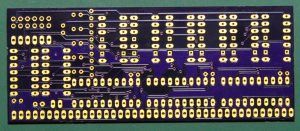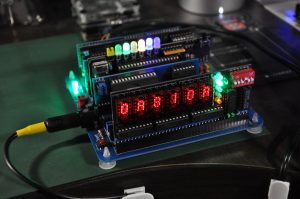From long time ago, I want to learn more deeply about computer, so I think I should learn about machine code and assembly language and master it at some point. Then learn how to program myself my own bios, device driver etc. It will take some process to learn this, and will make a lot of debugging. And of course to learn how computer work, it is good practice to pip around the computer system bus. So I decided to make a bus monitor for my RC2014 and use it when I do debugging process on learning and creating my own bios. This module is created by Dr. Scott M. Baker and the original info can be found from Dr. Scott blog [Z80 Retrocomputing 3 – Bus Monitor Board]. As Dr Scott make the board available at OshPark, I just ordered the board from OshPark, and as we all know it’s a little bit expensive.
So here is the fabricated PCB, look very nice with HASL finish. Let’s go and seek the components that we need to build this module.
Looks like there is not much to solder. I will put sockets to TIL311 display as this display is very expensive and I think I could reuse it later at some point. So let’s put it all together and make it run !
Ok, here is the board with all the components soldered. It is hard to decide the color of the LED’s as wrong color will result in difficulties of seeing what’s state in the bus later. I decided to use defused LED’s for indicating. Now it’s time to put all remaining components.
Here is the module ready to go. Looks very nice with the TIL311 display. Notice that this TIL311 display will drawn a lots of current and produce heat too, so if we are using voltage regulator on the backplane, be sure to use the regulator for current more than 1A. Really mean it, the TIL311 is really current hungry device !
Time to make some tests.
Yes, it works perfectly. Nothing we can see right now as the bus is operating at 7.3728MHz. We can only see something when we set the switch to monitor the I/O requests. I think I will need a board that can produce some slow clock effect, control the clock or can produce single step so that we can monitor the M1 and other state of the computer.
Overall, I think it is a very nice module and I want to thank to Dr. Scott for creating and make this module available on the public domain.









